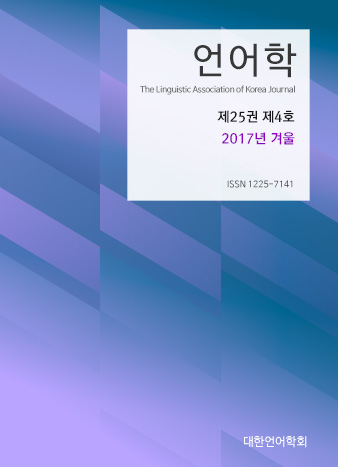대한언어학회 전자저널

25권 4호 (2017년 12월)
- 단어 말 두 음절의 강세 유형과 NONFINALITY 제약의 상관관계
-
조혜성
Pages : 167-191
Abstract
Cho, Hye-Sung. (2017). A correlation between the stress patterns of the last two syllables of a word and NONFINALITY constraints. The Linguistic Association of Korea Journal, 25(4). 167-191. Most of the discussion on the final stress avoidance phenomenon in recent metrical stress theory and the Optimality-Theoretic(OT) approach has focused on the prosodic status of a single, word-final syllable. If we extend this to the final two syllables of a word, however, we discover never-seen-before patterns of word-final stress avoidance, which include an asymmetry in typology between iambic and trochaic stress systems. Within the framework of the OT approach, this study explores the relationship between the stress patterns of the penultimate and ultimate syllables and NONFINALITY constraints in terms of final stress avoidance phenomenon. In particular, I note that there is no consistency in the way NONFINALITY(FT) constraint deals with final stress avoidance since it encompasses two unrelated stress phenomena, such as antepenultimacy and Foot Extrametricality. I argue that the double functions of the NONFINALITY(FT) constraint be taken over partly by a more specific NONFINALITY(σweak-in-foot) constraint and partly by a new alignment constraint, ALIGN-R(RIGHTMOSTNONHD(WD), PRWD), respectively.
Keywords
# 단어 말 강세 회피 # 단어 말 두 음절 # NONFINALITY 제약 # 운율 외 규칙(Extrametricality) # 정렬 제약(Alignment constraints)
References
- Cho, H.-S. (2014). The unstressable word syndrome in 2-syllable words. The Linguistic Association of Korea Journal, 22(4), 39-58.
- Gordon, M. (2000). The tonal basis of weight criterion in final position. Chicago Linguistic Society, 36, 141-156.
- Hayes, B. (1995). Metrical stress theory: Principles and case studies. Chicago: University of Chicago Press.
- Hyde, B. (2003). NonFinality. Unpublished manuscript. Washington University in St. Louis.
- Hyman, L. (1977). On the nature of linguistic stress. In L. Hyman (Ed.), Studies in stress and accent (pp. 37-82). Los Angeles: University of Southern California, Department of Linguistics.
- Kager, R. (1999). Optimality theory. Cambridge: Cambridge University Press.
- Kager, R. (2001). Rhythmic directionality by positional licensing. Paper presented at the Fifth Holland Institute of Linguistics Phonology Conference, University of Potsdam, January.
- Karvonen, D. (2008). Explaining NonFinality: Evidence from Finnish. In Proceedings of the 26th West Coast Conference on Formal Linguistics, 306-314.
- McCarthy, J. (2003). OT constraints are categorical. Phonology, 20, 75-138.
- McCarthy, J. (2008). The serial interaction of stress and syncope. Natural Language and Linguistic Theory, 26, 499-546.
- Mester, A. (1994). The quantitative trochee in Latin. Natural Language and Linguistic theeory, 12, 1-61.
- Morén, B. (2000). The puzzle of Kashmiri stress: Implications for weight theory. Phonology, 17, 365-396.
- Piggot, G., & Newell, H. (2005). Syllabification, stress and derivation by phrase in Ojibwa. Presented to the MOT Phonology Workshop-2005.
- Prince, A. (1990). Quantitative consequences of rhythmic organization. Chicago Linguistic Society, 26(2), 355-398.
- Prince, A., & Smolensky, P. (1993/2004). Optimality Theory: Constraint interaction in generative grammar. Malden, MA and Oxford, UK: Blackwell.
- Rice, C. (2005). Norwegian stress and quantity: Implications of loanwords. ROA #747.
- Trubetzkoy, N. S. (1939/1969). Grundzüge der Phonologie. Prague. [Principles of Phonology, Berkley: University of California University Press].